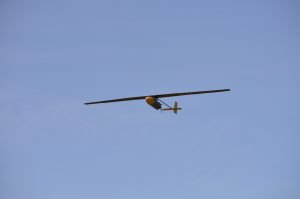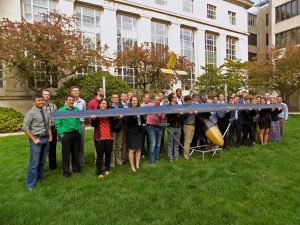Photo: Sally Chapman/MIT
Researchers at MIT have developed a gasoline powered drone with a 5 day flight time. The glider-like drone is designed to hold a communications payload that might set up a non permanent telecommunications community for catastrophe reduction.
The thought of utilizing drones to ascertain non permanent networks in catastrophe struck areas isn’t new; however most options are costly to function and will contain a relay system with a purpose to keep persistent protection. With present US Airforce options, MIT News reviews, “providing adequate and persistent coverage would require a relay of multiple aircraft, landing and refueling around the clock, with operational costs of thousands of dollars per hour, per vehicle.”
A workforce of MIT engineers has designed a drone “resembline a thin glider,” that gives a cheaper and longer endurance answer. “The vehicle can carry 10 to 20 pounds of communications equipment while flying at an altitude of 15,000 feet. Weighing in at just under 150 pounds, the vehicle is powered by a 5-horsepower gasoline engine and can keep itself aloft for more than five days — longer than any gasoline-powered autonomous aircraft has remained in flight,” says MIT News.

Photo: Veronica Padron/MIT
“The team is presenting its results this week at the American Institute of Aeronautics and Astronautics Conference in Denver, Colorado. The team was led by R. John Hansman, the T. Wilson Professor of Aeronautics and Astronautics; and Warren Hoburg, the Boeing Assistant Professor of Aeronautics and Astronautics. Hansman and Hoburg are co-instructors for MIT’s Beaver Works project, a student research collaboration between MIT and the MIT Lincoln Laboratory.”
Researchers had been initially approached by the U.S. Air Force to design a long-duration drone powered by solar energy; however the workforce quickly found that the mannequin didn’t work effectively for catastrophe reduction. “[A solar vehicle] would work fine in the summer season, but in winter, particularly if you’re far from the equator, nights are longer, and there’s not as much sunlight during the day. So you have to carry more batteries, which adds weight and makes the plane bigger,” Hansman says. “For the mission of disaster relief, this could only respond to disasters that occur in summer, at low latitude. That just doesn’t work.”
“These vehicles could be used not only for disaster relief but also other missions, such as environmental monitoring. You might want to keep watch on wildfires or the outflow of a river,” Hansman provides. “I think it’s pretty clear that someone within a few years will manufacture a vehicle that will be a knockoff of this.”
 Unmanned Aerial Vehicle The latest drone news
Unmanned Aerial Vehicle The latest drone news




